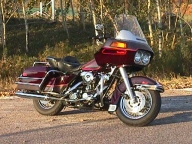
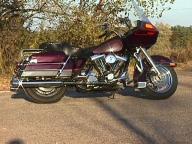
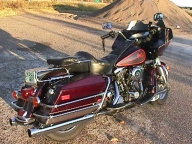
many roads have passed under these wheels - and hopefully many more to explore
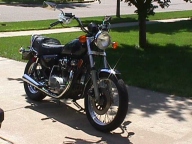

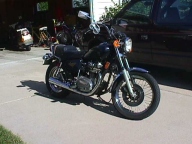
 |
 |
 |
|||||
|
many roads have passed under these wheels - and hopefully many more to explore |
|||||||
 |
 |
 |
|||||
| The cycle on the bottom is a venerable 1981 Yamaha 650 Special. The cycle on the top is a 1987 Harley Davidson FLTC, also called a Tour Glide. They are about as much fun as you can have with your clothes on. | |||||||
| THE ORIGINAL OWNERS | |||||||||||||||||||||
|
|
|
||||||||||||||||||||
| WEIGHT:lor | |||||||||||||||||||||
|
|
The Harley weighs nearly 800 pounds. | ||||||||||||||||||||
| LET'S GO! | |||||||||||||||||||||
| The 650 really excels in twisting country roads. I've tuned out the dual Mikuni carbs a little richer than usual. You can lay this bike right down to the ground, point it into a turn, then crack the throttle to cause the bike to roar back into the straight stretch.
The Yamaha 650 gets about sixty miles per gallon, but it only holds a little over two gallons. Good Metzler tires made a big improvement over the stock Yokohama tires which would be better suited to making rubber bullets or maybe those sandals with tire tread on the bottoms. The bike gets scary when going faster than 65 mph, although there is a lot left under the throttle. The cornering quickness, light weight, and massive vibration convert to a hair-raising experience when in the company of fast traffic. The dual overhead cam engine likes to be used as a brake on back throttle. That is nice, because the best you can say about the brakes is that they will slow you down a little bit if applied with enough force. The rear drum is pretty weak, and the front disk has a tendancy to throw the rider over the handlebars. Prepare to dive! Some adjustments to the front forks are probably in order. The bottom line is a fun bike that re-arranges your internal organs while you ride. |
The Harley excels on the open road. It runs effortlessly at highway speeds, but it won't lean very far without scraping. As my friend Mark V says, "If yer leaning that far you ain't riding, yer crashing!"
The brakes are excellent. The dual front disks and single rear disk are sure-footed and predictable, and the pedals are well-placed for using your weight to hold the bike, especially on hills. The 1340 cc motor gets over 45 miles per gallon, and the tank holds five gallons. The Harley has good manners in town, too. You don't have to shift very often, and it is a good thing you don't, because the transmission shifts like a tractor. A fast tractor. No speed shifts here. Its nice to shift into fifth gear at fifty miles per hour. The motor pours on the torque with a pleasing rumble. At this point, the Harley will walk away from the 650. The Harley goes where you point it so that you can enjoy the scenery, and the rubber-mounted Evo eats miles like candy. In any kind of weather. Going over foggy bridges in the early a.m. hours is like some kind of religious experience. |
||||||||||||||||||||
|
THINGS I LEARNED NOT TO DO: |
|||||||||||||||||||||
| Don't rev the bike up when it is resting on it center stand on a slippery garage floor. You can imagine the expression on my face as the bike (with me on top of it) spun around quickly in a complete circle. Also, don't park the 650 pointing downhill. It is best to never trust the Yamaha kickstand. Don't wear good clothes too soon after you have lubed the chain, because you will look like you have been in some kind of an oil rig explosion. Don't plan long trips riding two-up unless you both don't mind feeling jack-hammered. | Don't let a Harley idle and then get off the bike if it is pointing downhill even slightly. I was surprised when the idling hog began dragging itself down my driveway without me on it. Grind, scrape, grind, scrape. But the kickstand held! The Harley manual calls it a "jiffy stand". Bwahaha! I was closing the garage door when I heard the sound as the Harley attempted to reach the open road. It dragged itself down the driveway, but never fell over. I soon learned to trust that big chrome kickstand.It will even keep the bike up on sand. Also, it is easy to forget how heavy the bike is when it is rolling, but a careless stop in gravel will soon remind you. | ||||||||||||||||||||
| DESIGN | |||||||||||||||||||||
| The Yamaha design is a visual copy of England's Triumph Bonneville, with several updates. Overhead cam, dual Mikuni CV carbs, five speed tranny. The bike is made of good materials - high quality castings, lots of aluminum, and check out the chrome, especially the fenders!
The valve clearances are easy to adjust, and the gearbox is quick-shifting and reliable. However, the clutch cable is exposed to the elements as it passes through the crankcase cover into the clutch mechanism, causing a few problems. A simple sleeve would have protected the whole thing. The electrical system seems to pre-date Thomas Edison and the lights were reportedly designed by the prince of darkness. The headlight is a glimmer from the past, and the electric starter is vastly underpowered. When the electric start button broke off, I didn't bother replacing it. The kick starter is cool, however. You get one real strong leg from using it. The carburetors are flawless. This bike has never backfired or faltered once, except when the battery died or something broke (twice-but that is two other stories.). The fuel petcock assembly could use some work. The diaphrams have a tendency to fail, causing a gas-soaked left leg. Parts for this bike are incredibly inexpensive, and still available. The good basic design eases the most common repair tasks. I like this bike because it has lots of pure motorcycle essence, sound and looks, and it is reliable. The older it gets, the more I like it. I keep it in case society breaks down and I need simple economic transportation. It sits in my garage right now, stripped down to locate an electrical fault that would intermittently cause the bike to kill and stay dead for days on end. It turned out to be the kill switch! I like to look at the bike all stripped down like that. It looks pretty sweet that way, so I think I'll put it back together a little differently to accent the lines that I like in it.
|
The Harley design is true to an
old bloodline. Single crank pin, pushrods, lifters, etc. Its a beauty.
I had put a lot of miles on the Yamaha 650 when a friend (D.H.) let me drive his Harley and I was hooked. You can feel history in its components.
It feels like the way to see America. Like they say, to hell with the
new millenium. The belt drive and electric start are
done right, without giving up the things that people always liked about these machines. It has a personality.
It leaks genuine Harley oil, (not much) and farts occasionally. It is hard to explain the fun that comes from driving it, but the force is very strong. When you shut it off, the bike crackles and pops as the various metals relax. The parts are so solid that the old 650 feels flimsy by comparison. To be fair, the difference in price is as great as the difference in bikes. The bike is built to be worked on, but I let the pros with the proper tools and knowledge do the real tricky stuff. There hasn't been much of that. It was finally time to replace the vintage Kehin butterfly carb. It finally crapped out at about 35000 miles. The guys at Northland Cycle came up with a new Kehin CV carb from a trade-in and they did a beauty job installing it. At 40000 miles, the bike runs better than ever. This bike really opened up a lot of possibilities . You can ride all day and still feel like partying when you get there. The Paucho fishtail exhausts still sit in the garage (too loud for the neighborhood), so the old punched-out stock pipes do the job. By the winter of 2007 we had about 118,000 miles on the bike and it was running well but I thought I'd take the opportunity to put a new Harley reman program motor . They might not make 1987 bolt-in replacement motors forever. I got a new belt, too, even though the old one looked almost flawless! People at the Rice Lake Harley shop that did the work were surprised how nice the belt looked. So I got the new motor and belt and we headed through the mountains to Colorado in the springtime, where I promptly put a rock through my brand new belt! The little thumbnail-sized rock is still in there after about fifteen thousand more miles, and that is where it is going to stay, I hope. If I hadn't seen it when getting a new back tire, I would never know it was there. Check out some bike trip stories here. See you on the road! |
||||||||||||||||||||